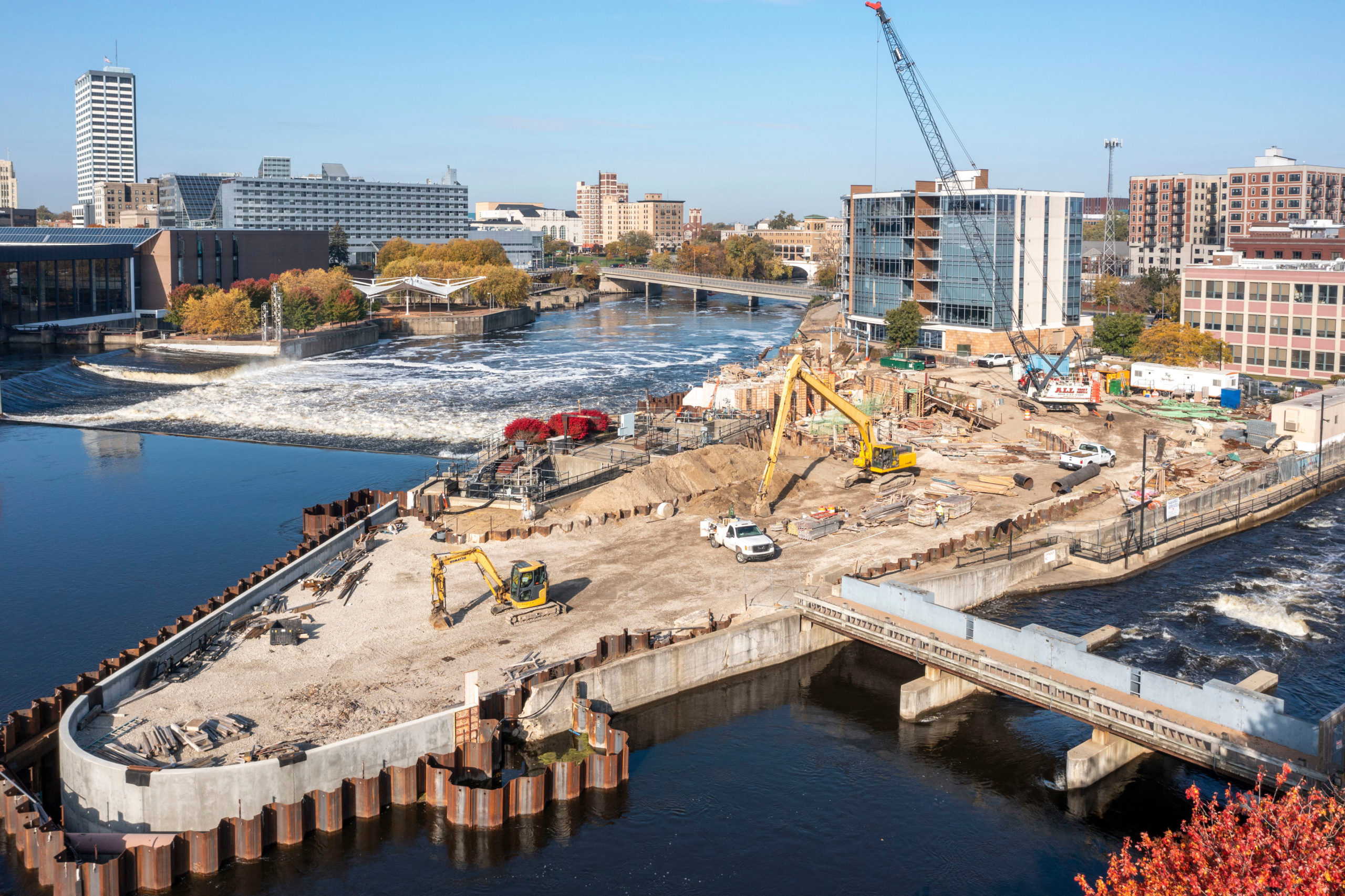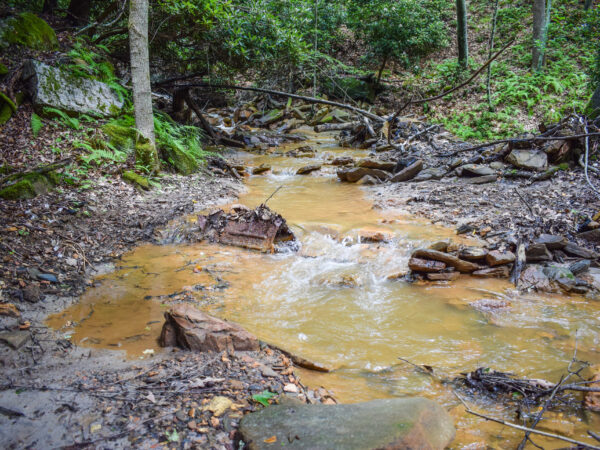
By Christopher Parker, National Newspaper Association Foundation News Fellows Program
Great Lakes Now is publishing this story in conjunction with the National Newspaper Association Foundation’s News Fellows Program. In March, during NNA’s Community Newspaper Leadership Summit, a group of student journalists met with experts and policy leaders in Washington D.C. to discuss the topic of climate change. The students then further reported and wrote articles like this one for publication in state press association member media outlets. Great Lakes Now is a Michigan Press Association member.
Hydroelectric power is the oldest source of energy in the world, and the state of Indiana is no exception to that history.
The St. Joseph River, which winds west into northern Indiana on its way to Lake Michigan, has long been a source of power in the town of South Bend. As early as the 1860s, mills churned on the river’s races and provided reliable free power.
And 160 years later, Paul Kempf, the assistant vice president for utilities and maintenance at the University of Notre Dame, is wrapping up a project to once more harness the strength of the St. Joseph. Almost a decade in the making, the new downtown hydroelectric plant will provide 7% of the university’s power.
“We haven’t paid somebody two states away to plant trees or put in solar panels or wind power,” he said of the project. “We wanted to reduce our own carbon to the best of our ability.”
The city of South Bend received a federal exemption for a hydroelectric dam almost 40 years ago but never built the facility due to cost. They transferred the exemption to Notre Dame in 2014 for a 2.5 megawatt facility on the St. Joseph, and the university broke ground in 2019. It is expected to begin operation later this summer.
Hydroelectric power is a relatively small slice of Indiana’s renewable energy generation. In this state, wind turbines contribute over 75% of the grid’s green energy.
But that might be changing. Wind power is proving more divisive than hydroelectric, and new technologies under development could reimagine the way water helps keep the lights on.

A new hydropower plant is in the midst of construction on the St. Joseph River in downtown South Bend, Indiana. Construction was happening through winter 2021, pictured. (Photo Credit: University of Notre Dame)
Region’s lowlands pose an obstacle
As the world’s most popular source of renewable energy, hydroelectricity contributes roughly 17% of global energy production, according to the International Energy Agency. Hydropower plants have existed in this country for centuries in some form. But Indiana in particular never expanded on the technology like other states did.
Part of the reason is the region’s flat geography. The Great Lakes Basin is mostly lowlands that lack the steep drops or large rivers to support sizable facilities. The largest hydroelectric facilities in Indiana, Michigan, Ohio and Wisconsin support capacities of 45 megawatts, 30 megawatts, 105 megawatts and 48 megawatts respectively.
Meanwhile, the largest facility in Washington, the state which generates the most hydroelectric power in the U.S., has a capacity of 4,215 megawatts.
Most of Indiana is far better suited for wind turbines. But while wind technology has become cheaper and more efficient in recent decades, it has also been subject to increasing backlash.
Jennifer Miller is the president of a grassroots political group called Hoosiers for Reliable Energy, and she successfully lobbied for a moratorium on wind farm construction in Marshall County back in 2013. Miller owned property nearby and complained that wind farms are noisy and unsightly.
“They don’t make good neighbors,” she said. “People don’t want to live next to these things.”
Miller’s group took action to block Senate Bill 411 last year, which would have required Indiana counties to make themselves wind- or solar-friendly through a set of shared standards. Miller herself penned an op-ed protesting the bill. When a more moderate version of the bill passed into law this year, making those standards optional, Miller still protested, calling it “a love letter to wind and solar industries and a blatant disregard for rural Hoosiers” in the Indianapolis Star.
Although she has a well-documented opposition to wind farms, Miller said she sees hydroelectric power as more reliable and less obnoxious. She emphasized that “we’re not anti-renewables” and added that the dependable nature of water flow gives her much more confidence in its ability to generate power.
Her viewpoint is a common one. In a Princeton Survey Research Associates study, over 70% of Americans polled believe water power is cleaner and more reliable than other forms of renewable energy.
But how can Indiana source more hydroelectric power with its geographical challenges?
Abandoned mines offer hydropower infrastructure solution
One answer might be PSHAUM: pumped-storage hydropower using abandoned underground mines.
PSHAUM technology is a new take on an established hydropower practice called pumped-storage. The idea is to connect two bodies of water, one at a higher elevation than the other, using a pipe with a turbine inside. On a sunny or windy day when other renewables can provide energy, some of that energy is used to pump water up to the higher elevation. Then, on days when wind or solar aren’t producing, water can flow through the turbine down to the lower elevation and provide power.
Pumped-storage systems store energy like a battery, and that helps utilize any surplus power generated by renewables or provide a clean and cheap alternative when demand is high.
A PSHAUM project would artificially create this setup in flat Indiana by enlisting unused underground real estate, according to Kevin Ellett, president and co-founder of Bloomington-based Carbon Solutions, LLC.
“By repurposing old underground mines into lower reservoirs for PSHAUM, we will be able to open up whole new areas of the country for pumped-storage hydropower – places like Indiana where we do not have the natural topographic relief to support the development of traditional pumped storage facilities,” Ellett said in an email.
The technology is still under development. But in March, Indiana Gov. Eric Holcomb signed Senate Bill 147 into law, adding underground pumped storage hydropower to the list of the state’s “clean energy resources” and clearing the way for further investment in the practice. Between the House and the Senate, nobody voted against the bill.
In general, American public support for green energy is high.
Many opponents of green energy projects, like Miller and her group, consider themselves open to renewables, but only when they believe the infrastructure won’t disrupt their quality of living or crash under high demand.
Hydropower has the potential to waylay both those fears, and with new opportunities for creative hydro facilities in Indiana, the state is poised to make way for water.
Catch more news on Great Lakes Now:
Indiana might be changing its tone toward wind energy
Hydropower eyes bigger energy role, less environmental harm
Energy News Roundup: Indiana sees price hikes, Pennsylvania, Wisconsin and Ohio struggle with solar
Featured image: A new hydropower plant is in the midst of construction on the St. Joseph River in downtown South Bend, Indiana. Construction was happening through winter 2021, pictured. (Photo Credit: University of Notre Dame)




